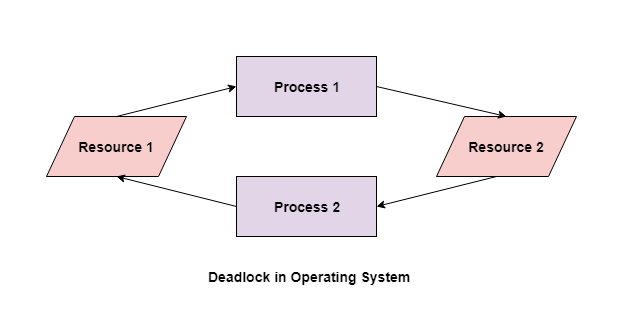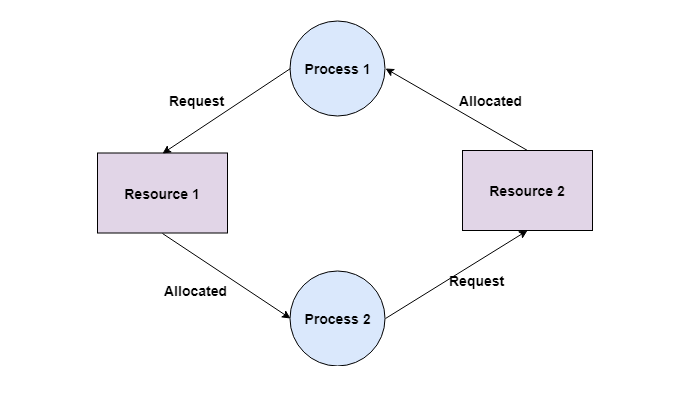
 Data Structure
Data Structure Networking
Networking RDBMS
RDBMS Operating System
Operating System Java
Java MS Excel
MS Excel iOS
iOS HTML
HTML CSS
CSS Android
Android Python
Python C Programming
C Programming C++
C++ C#
C# MongoDB
MongoDB MySQL
MySQL Javascript
Javascript PHP
PHP
- Selected Reading
- UPSC IAS Exams Notes
- Developer's Best Practices
- Questions and Answers
- Effective Resume Writing
- HR Interview Questions
- Computer Glossary
- Who is Who
Process Deadlocks in Operating System
A deadlock happens in operating system when two or more processes need some resource to complete their execution that is held by the other process.
In the above diagram, the process 1 has resource 1 and needs to acquire resource 2. Similarly process 2 has resource 2 and needs to acquire resource 1. Process 1 and process 2 are in deadlock as each of them needs the other's resource to complete their execution but neither of them is willing to relinquish their resources.
Coffman Conditions
A deadlock occurs if the four Coffman conditions hold true. But these conditions are not mutually exclusive.
The Coffman conditions are given as follows ?
-
Mutual Exclusion
There should be a resource that can only be held by one process at a time. In the diagram below, there is a single instance of Resource 1 and it is held by Process 1 only.
-
Hold and Wait
A process can hold multiple resources and still request more resources from other processes which are holding them. In the diagram given below, Process 2 holds Resource 2 and Resource 3 and is requesting the Resource 1 which is held by Process 1.
-
No Preemption
A resource cannot be preempted from a process by force. A process can only release a resource voluntarily. In the diagram below, Process 2 cannot preempt Resource 1 from Process 1. It will only be released when Process 1 relinquishes it voluntarily after its execution is complete.
-
Circular Wait
A process is waiting for the resource held by the second process, which is waiting for the resource held by the third process and so on, till the last process is waiting for a resource held by the first process. This forms a circular chain. For example: Process 1 is allocated Resource2 and it is requesting Resource 1. Similarly, Process 2 is allocated Resource 1 and it is requesting Resource 2. This forms a circular wait loop.
Deadlock Detection
A deadlock can be detected by a resource scheduler as it keeps track of all the resources that are allocated to different processes. After a deadlock is detected, it can be resolved using the following methods ?
- All the processes that are involved in the deadlock are terminated. This is not a good approach as all the progress made by the processes is destroyed.
- Resources can be preempted from some processes and given to others till the deadlock is resolved.
Deadlock Prevention
It is very important to prevent a deadlock before it can occur. So, the system checks each transaction before it is executed to make sure it does not lead to deadlock. If there is even a slight chance that a transaction may lead to deadlock in the future, it is never allowed to execute.
Deadlock Avoidance
It is better to avoid a deadlock rather than take measures after the deadlock has occurred. The wait for graph can be used for deadlock avoidance. This is however only useful for smaller databases as it can get quite complex in larger databases.






